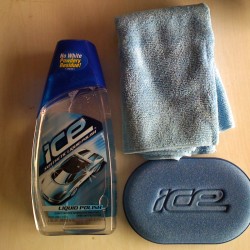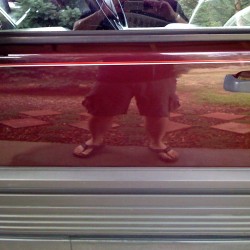Car care review - Turtle Wax ICE vs. Zaino
The good folks over at Turtle Wax sent me a package of their latest car-care line, ICE, in order to give it a try and let everyone know what I thought. Now, I don't know about you, but I'm a bit leery of using an unknown product on anything as precious as a Cadillac - so I decided to try this out on my winter car, a 1995 Jeep (the paint on which is in fine shape except for a few scratches).
Now, simply putting any product on a previously unwaxed car isn't going to be a good test - so I pulled out the big guns for a side-by-side (literally) comparison - Zaino.
For those of you unfamiliar with Zaino - this is a non-wax product that, through the application of multiple layers, provides a glossy, deep, protective layer. I've used them for years with no complaints.
ICE is a new product from Turtle Wax that is also a non-wax promised to result in no white dust, can be used on just about all surfaces of your car short of tires (though they make a point of saying it can be applied to rubber) and windows. ICE is also touted to provide deeper shine through multiple coats (for this comparison, I only applied one coat).
So, on to the comparison:
The players
Playing for the ICE team:
ICE Liquid Claybar
ICE Liquid Polish
And for Zaino:
Z-18 Clay bar
Z-2 Pro Show Car Polish for Clear Coat (note: To properly perform a Zaino application, I should have started with Z-1 Polish Lok or ZFX flash cure...but I did not want to take the additional time to use my left over Z-1 and have not yet purchased any ZFX)
Initial Prep
To get things going, I took a bucket of dish-washing soap to the two drivers-side door panels in order to remove any dirt and any possible wax residue/coating that might have been left behind. This got us down to just paint on a door...a great starting point to any wax you want to apply. This is a picture of our starting point:
Procedure
For this comparison - I applied the Zaino products to the driver's front door and ICE to the rear door.
Clay-ing
Claybar-ing your paint is a process to remove embedded contaminants from the surface. Traditionally, you use a bar of clay or clay-like material, a liquid to lubricate the bar, and slowly work it across the surface. The clay should be more attractive to any particles embedded in the paint than the paint is and will draw them out of the surface. Repeated folding over of the bar is required to keep presenting a clean clay surface to the paint (to prevent any contaminants you've removed from damaging the paint you pull the bar across later on).
Zaino's Z-18 Clay bar is a very traditional clay bar...as shown here:
Turtle Wax has done something odd with their product, the ICE Liquid Clay Bar. They describe it as:
A unique triple layer formula consists of a scratch & swirl remover, cleaning agents and an exfoliant that work together to provide outstanding cleaning capabilities.
This sounds less like a clay bar and more like a mild polish...so we'll take their calling this a 'clay bar' with a very large grain of salt.
The process for using the Zaino Claybar was simple. Work the bar in your hands to get some heat into it and soften it. Fold it over itself a few times until it is nice and pliable. They spray the surface with either water, with just a tiny bit of soap mixed in, or you may use a detailing spray. The idea is to get a thin layer of liquid for the bar to slide on, but not so much that the bar doesn't touch the surface. I like to work in small areas, at most a couple square feet at a time. I then slide the bar in straight lines over the area from one side to the other, doing 2 strips or so before taking the bar and folding over the 'working' side to wrap the now dirty side into the bar and then continue with a side that has not been used against the paint (which should be any side since you just folded the used side into the clay).
For the ICE 'claybar' I used the included applicator pad and followed the instructions on the bottle. After using both products, I could not see much difference between the left (claybar-ed) and right (mildly polished) finishes.
Polish
Now it's time for what many people would call the actual 'wax-ing' step. Zaino used to use a system that required a use of their Z-1 'Polish Lok' that you applied but did not buff off followed by the actual Z-2 Polish coat that you then allowed to dry before buffing off. Now, they have an additive (ZFX) you add to the Z-2 to accomplish the same result. I skipped the Z-1 step because I have am almost out and also did not use ZFX as I have not purchased any yet. Since both seem to be more about durability of the final coat than shine performance - I did not feel this would impact the final comparison. Z-2 is a creamy, pink substance that you apply with a rag or other applicator. I applied this to the panel in circular motions until I had the entire surface lightly coated. I waited for this to dry completely before buffing off with a cotton or microfiber cloth. It dries to a haze like this:
ICE Liquid Polish (they also make a paste version for those who like the more traditional Turtle Wax polish method) comes with its own foam applicator pad and a microfiber cloth. It is a clear, slightly thick liquid. Following the included instructions I applied a layer of the polish over the panel in straight, overlapping strokes.

Ultimately, you have a distorted layer of liquid on the panel as shown below. After letting the ICE sit for a few minutes, it is still wet, but this is the time to buff off the excess with the included microfiber cloth. After completing both panels - each with a single coat of polish - I was left with the following results (each pair is Zaino followed by ICE.
Click any picture for a more detailed version):
Conclusions
We can make some definitive conclusions from this test...
1. My Jeep has a fair number of scratches.
2. Jeep paint has a fairly breathtaking level of orange peel from the factory.
3. Obviously, this is a fairly limited comparison based on the appearance right after applying both products. This does not take into account the results after multiple applications nor the longevity of either product.
However, after applying both Zaino and ICE, I personally can see a deeper, clearer shine from the Zaino product, even taking the shortcut of not using the Polish Lok/ZFX method.
The easier application of ICE, it appears, is made up for by the fact you would need to apply more than 1 coat to reach even the results of a single Zaino coat. Before making a final recommendation, we should at least make a nod to the ugly subject of price.
Zaino pricing looks like this (note that Zaino is available only online from Zaino Brothers) (updated as of 4/30/2019):
Z-2 - $16.95
Z-18 (claybar) - $17.95
Z-6 detailing spray (can be used to lubricate the clay bar - though water with a small drop of soap will work just as well) - $11.95
ICE is available at many retailers - but I'll use Amazon for the price comparision:
ICE Liquid Polish - $14.94
ICE Liquid Claybar - $19.94
ICE Spray Detailer (not needed since the claybar isn't of the traditional type) - $12.99
So, surprisingly, ICE doesn't bring a compelling price advantage to the table either.
So, in the end, if you don't have to pick up a bottle of something to polish your car _right now_...it appears that Zaino would be the way to go. If you are pinched for time, would like to use one product on both paint and plastic trim, or don't mind multiple applications to get comparable results - then ICE certainly is an adequate option.
Turtle Wax ICE - Amazon link - purchases help support tCE


















